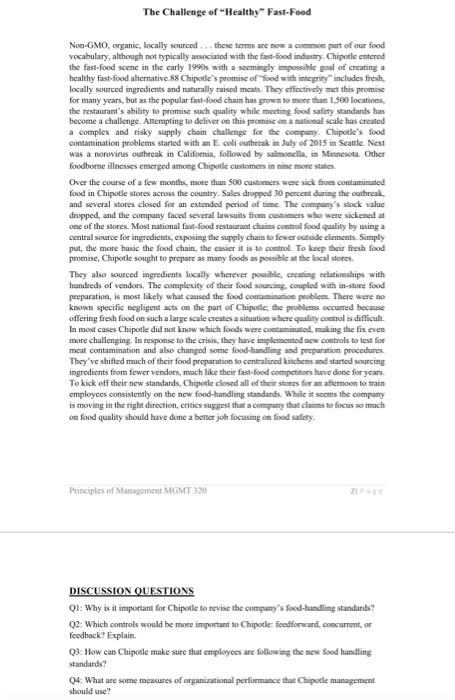Answered step by step
Verified Expert Solution
Question
1 Approved Answer
please answer these four questions. Non-GMO, organic, locally sourced ... these terms ane now a commen purt of our food vocabulary, although not typically associated
please answer these four questions. 
Non-GMO, organic, locally sourced ... these terms ane now a commen purt of our food vocabulary, although not typically associated with the fect-food industry. Chipotle entered the fast-food seene in the carly 1990 s with a secmingly imponsible goul of creating a healthy fast-food alternative 88 Chipotle's promise of "food with integrity" includes fresh, locally sourced ingredients and naturally raised meats. They effoctively met this promise for many years, but as the popular fast-food chnin has grown to more than 1,500 locations, the restaurant's ability to promise such quality while mocting food safcty standards has become a challenge. Amempting to deliver on this promise on a natioeal scale has creaned a complex and risky supply chain challenge for the compuny. Chipolle's food contamination problems started with an E. coli ourbrcak in July of 2015 in Seattle. Nied was a norovins outbreak in Califomis, followed by salmonella, in Minnesota. Orher foodborne Hllnesses emerged among Chipotle customers in nine mote states. Over the course of a few months, mote than 500 customers were sick from contaminated food in Chipotle stores across the country. Sales dropped 30 percent dering the outhreak, and several stores closed for an extended period of time. The company's stock value dropped, and the company faced several lawsuits from casoeners who were sickened at one of the slores. Most mational fest-food restaurant chuins coetrol food quality by using a central source for ingredients, exposiag the supply chain to fower outside elements. Simply put, the more basic the food chain, the easier it is to control. To kecp their fresh food promise, Chipotic sought to prepare as many foods as posible at the local stores. They also sourced ingredients locally wherever posible, creatieg telutiveshaips with hundreds of vendors. The conaplecity of their food souncing, coupled with in-store food peeparation, is most likely what caused the food comamination problem. There were no known specific negligent acts on the part of Chipotle, the problems occurred because offering frech food on such a large scale creates a situation where quality coetrol is difficult. In most cases Chipotle did not know which foods were contaminated, making the fix even more challenging. In respoene to the crisis, they have implemented new cuetrols to test foe meat contamination and also changod some food-handling and prcpuration procedures. They've shifted mach of their food preparation to centraliond kitehens and started sourcing ingredients from fewer vendors, moch like their fist-food cempetidors have done for years. To kick off their new standands, Chipotle elosed all of their stores for an affernoen to train employees consistently on the new food-handling standards. While it socms the company is moving in the right direction, critics suggest that a coenpuny that claims to focus so mukh on food quality should have done a better job focasing on food safety. Prisciples of Mansgement MGMT 320 DISCUSSION QUESTIONS Q1: Why is it important for Chipotle to revise the compumy's food-handling standarts? Q2: Which controls would be more important to Chipotle: feedfiorwand, coccurtent, or feedback? Explain. Q3: How can Chipotle make sure that employces are following the aew food handling standarts? Q4: What are some measures of organizational performunce that Chipole management should use 
Step by Step Solution
There are 3 Steps involved in it
Step: 1

Get Instant Access to Expert-Tailored Solutions
See step-by-step solutions with expert insights and AI powered tools for academic success
Step: 2

Step: 3

Ace Your Homework with AI
Get the answers you need in no time with our AI-driven, step-by-step assistance
Get Started


